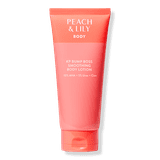
Keratosis pilaris, known as KP for short, is a skin condition that manifests in tiny red bumps that appear on the body, like the backs of arms and legs. It's not widely understood why some people experience KP while others don't, but it's not at all uncommon: the Cleveland Clinic has estimated that the condition impacts up to 50 percent to 80 percent of teenagers and 40 percent of adults. While it's something that people experience year-round, it's especially top of mind as the weather warms up. When the shorts and tank tops go on, smooth, bump-free skin might become a priority, but KP poses some difficulties.
Occasionally referred to as chicken skin (and we'll let you use your imagination as to why), KP is caused by keratin plugs inside of hair follicles, resulting in tiny, inflamed, hard bumps. They're not pimples, though they're often mistaken as such, and they don't really go away on their own until around middle age. Still, while the condition is harmless and painless, many people consider the bumps not ideal. If you fall into that category, luckily, there are a handful of treatment options available to you, from topical lotions to body scrubs.
Keratosis Pilaris Treatment
KP requires a slightly different treatment approach to acne (because remember: they're not the same). Because the condition is caused by keratin buildup on the surface of skin, you need to focus on exfoliation - either chemical or physical - to keep skin smooth. Then, because dry skin can exacerbate the situation, hydration is another key component of KP treatment.
"Lactic-acid-based chemical peels can be a good starting point to smooth the skin," Jennifer Linder, MD, dermatologist and PCA Skin chief scientific officer, previously told POPSUGAR. What you don't want to do is attempt to pop the bumps. "Avoid picking at keratosis pilaris - it causes inflammation and irritation."
Again, the skin condition is not an uncommon one. If you're on the hunt for the best keratosis pilaris treatments, keep scrolling to shop for products specifically designed to tackle these tiny red bumps.
- Additional reporting by Emily Orofino
